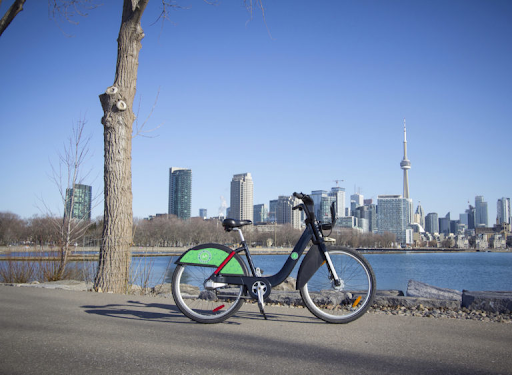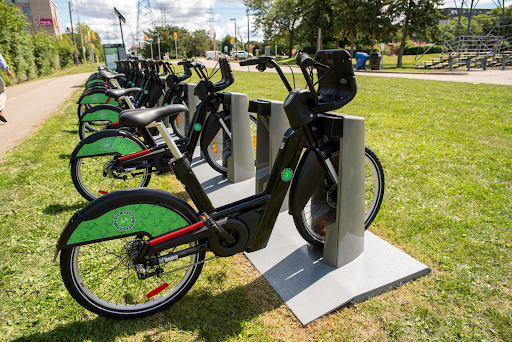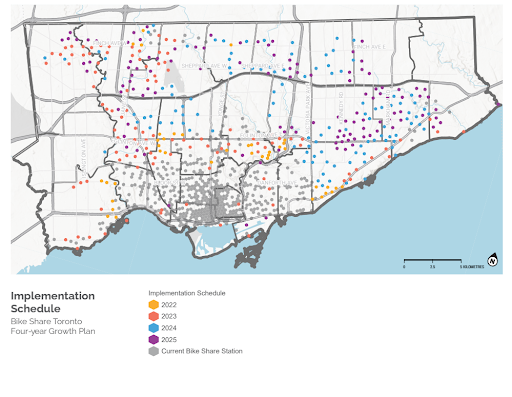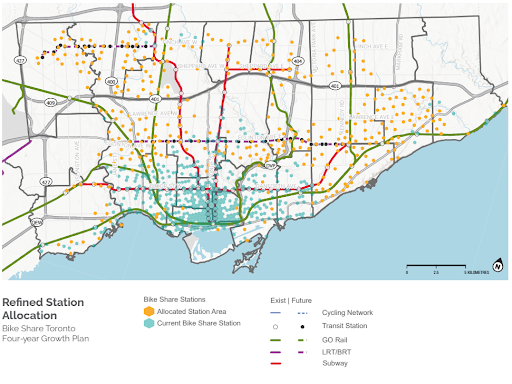Bike Share Toronto’s Four-year Growth Plan: A Data-driven, Community-focused Network Expansion
20 minutes Author: Shared-Use Mobility Center Date Launched/Enacted: Mar 27, 2023 Date Published: March 27, 2023

Since 2021, the Shared-Use Mobility Center (SUMC) has convened an Innovative Transit Micromobility Integration (ITMI) working group. In these working group meetings, representatives from transit agencies discuss challenges and strategies they face in integrating micromobility programs into their transit systems, and share knowledge and resources to learn from each others’ experiences. This case study is part of SUMC’s technical assistance work for the FTA that is conducted under the Mobility Innovation Collaborative program, and incorporates knowledge gained from a guest presentation at one of these working group meetings.

Watch a presentation on Bike Share Toronto from Cai de Ridder, Senior Planner with the Toronto Parking Authority
Credit: SUMC
Originally Published March 2023, Revised March 2025.
Introduction
Bike Share Toronto is a publicly owned and managed bikeshare system operating in Canada’s largest city of Toronto, Ontario. As one of the largest and oldest bike share systems in North America, it has consistently evolved since its inception in 2011 to meet the needs of the nearly 2.8 million Toronto residents. Bike Share Toronto is currently working on its Four-year Growth Plan, an initiative to guide the system’s expansion to all 25 wards of the city by 2025. Through this expansion, Bike Share Toronto hopes to build a more accessible and convenient system.
History
The first iteration of bikeshare in Toronto was BIXI Toronto, which launched in 2011 with 1,000 pedal bikes and 80 stations spread throughout downtown. BIXI Toronto was initially operated by Public Bike System Company (PBSC), but PBSC soon faced difficulties keeping the system financially sustainable. The City of Toronto took over the bikeshare system in 2013, and transferred management to the City of Toronto’s Transportation Services division. As it became publicly owned and managed, BIXI Toronto was rebranded as Bike Share Toronto. In 2016, the Toronto Parking Authority (TPA), the agency that manages public parking facilities and operations throughout the city, took over operations and began plans to guide expansion of the system.
Since becoming a mobility option for Toronto’s residents and visitors, annual ridership has grown from about 500,000 rides in its first year in 2011 to over 4,500,000 trips in 2022, an increase of about 450% in a decade. Bike Share Toronto now serves roughly 400,000 riders per year, 30,000 of which have annual memberships.
Operations
Bike Share Toronto is owned and operated by the Toronto Parking Authority (TPA), an agency of the City of Toronto. TPA plans the system, manages contracts, purchases equipment, and coordinates with the city for expansion plans. Equipment is provided by PBSC (now owned by Lyft), and most system operations, including maintenance and rebalancing, are contracted out to a third party.
Bike infrastructure in the City of Toronto is managed and owned by the Toronto Transportation Services, which permits bikeshare docking stations to use space in the public right of way. The exceptions to this are the 12 stations in the city that are located within surface parking lots or garages. Since TPA owns and manages these parking facilities, there is no need for coordination between agencies for the bike share stations at those public parking locations.
TPA works with other transportation services in Toronto to find space for bikeshare stations at subway, regional train, and light-rail transit stations throughout the city to facilitate key first/last mile connections.
As a subsidiary of TPA, Bike Share Toronto is funded primarily through parking revenue. Other minor funding sources include advertising and pass sales. Bike Share Toronto also receives intermittent funding every few years from the Government of Canada and Metrolinx, Ontario’s provincial transit agency, to purchase new bikes.
As of 2023, there are a total of 7,100 available bikes in 20 of the city’s 25 wards. In 2021, Bike Share Toronto added 300 e-bikes to its fleet, and 15 of the system’s 670 docking stations are now capable of charging e-bikes. These are a mix of brand new e-stations and stations retrofitted to accommodate charging. For both new and retrofitted e-stations, finding sufficient power is a challenge; new e-stations are currently installed at TPA-owned carparks with on-site power, or as part of new developments. TPA locates as many e-stations as possible in Bike Share Toronto’s core service area where ridership is highest.
TPA is considering expanding the number of e-bikes and stations capable of charging e-bikes in the coming years, and is currently assessing the cost and operational impacts of more e-bikes, as well as battery swapping for e-bikes. TPA estimates that reaching 10-15% of Bike Share Toronto’s stations capable of charging e-bikes in strategic locations will allow the agency to deploy a larger fleet of e-bikes with a lower operational cost, as a result of streamlining the battery recharging process.
Bike Share Toronto provides an all-season service. Bikes are available 24 hours a day, 7 days a week, and year-round, even through Toronto’s usually cold and snowy winters. While ridership fluctuates due to weather conditions, people ride Bike Share Toronto all year. Users check out bikes through the Bike Share Toronto PBSC mobile app, or can purchase membership cards through station kiosks or online.

A Bike Share Toronto e-bike Docking Station. Credit: Bike Share Toronto
Four-Year Growth Plan
Bike Share Toronto’s success since its inception has led to its Four-year Growth Plan, an initiative adopted in 2022 to address the system’s development throughout the city. The plan is being developed in conjunction with TransformTO.
Goals
TPA has seen ridership and community support steadily grow for Bike Share Toronto, but the agency is on track to exceed its capacity to operate the bikeshare system. The Four-year Growth Plan aims to help build capacity while increasing system accessibility. The plan guides how to steer expansion through five goals:
- Enabling the highest potential ridership
- Limiting geographic and topographic barriers
- Enhancing first and last mile connectivity; and
- Considering the revenue potential of the system
Additionally, TPA has specific goals to have over 1,000 docking stations installed throughout the city with 10,000 available bikes by 2025, and to continue the network electrification by introducing more e-bike stations.
Community Engagement and Outreach
A key component of the Four-year Growth Plan is to engage with key stakeholders and community members to understand how the current bikeshare system could be enhanced. TPA’s community outreach involved stakeholder workshops, group meetings, and public consultation sessions, workshops and surveys. These public consultation efforts were undertaken to help community members and stakeholders understand the vision of the expansion, ensure that TPA’s plan was usable and amenable, and be in a better position to meaningfully integrate bikeshare into new communities.
TPA has coordinated with the Toronto District School Board and the Toronto Catholic District School Board, as well as some post-secondary institutions, including York University, to determine how to best serve the student population. Students comprise a large portion of Bike Share Toronto’s customer base, so partnerships with school boards and universities helps TPA strategically guide expansion.
Guiding Expansion through Data Analysis
The Four-year Growth Plan is heavily data driven. Though bikes are currently available in 20 of the city’s 25 wards, the system is largely concentrated in Toronto’s Downtown and Midtown districts. However, Toronto spans more than 630 sq km (243 sq. miles), and a major expansion goal of the Four-year Growth Plan is to make bikeshare available more universally, with stations in all 25 wards. The TPA performed various geospatial analyses to explore different expansion options. Through these analyses, TPA has determined various priority areas around the city based on ridership demand and potential areas that bikeshare can improve first/last mile access, corridors with existing or planned cycling infrastructure investment, and areas of projected population and employment growth.
TPA developed a custom scenario allocation and evaluation tool, which weighs and scores the priority areas determined from the geospatial analyses to create scenarios which can be evaluated by TPA to inform the distribution of potential station siting.
TPA will introduce new stations incrementally over the course of the plan. The first two years of the Four-year Growth Plan are primarily focused on extending the existing service area, while 2024 and 2025 focus on reaching locations more distant from the core downtown service area. In total, TPA will add 375 new bikeshare stations throughout the city by 2025.

Bikeshare station implementation schedule. Credit: TPA
One major challenge that TPA sought to address was maintaining a connected network around Highway 401, which runs east-west in the northern part of the city, and is the busiest highway in North America. With only two bicycle-friendly crossing trails (the Humber and Don Trails), this highway poses a major barrier to bicyclists moving between wards. Focusing on maintaining a unified network, TPA modified the scenario generated by their analysis and created corridors of bikeshare stations leading to the two crossings. The scenario further includes a relatively dense network of planned stations north of Highway 401, ensuring better integration of satellite stations, and allowing riders to have better access to the bikeshare network on both sides of the highway. TPA has been able to direct the network expansion with help from these tools and analyses to target priority areas and keep the system cohesive, connected, and useful, despite physical barriers.

Map of existing and planned bikeshare stations in relation to other transportation modes. Credit: TPA
Conclusion
As a publicly owned and managed bikeshare system, Bike Share Toronto is a relatively unique case in North America. The system is financially stable; both capital and operating costs are paid by the TPA’s parking revenue, pass purchases, and advertising on bikeshare equipment.
Bike Share Toronto exemplifies how a bikeshare program can integrate with city services, further local transportation goals, and address mobility needs and demands.